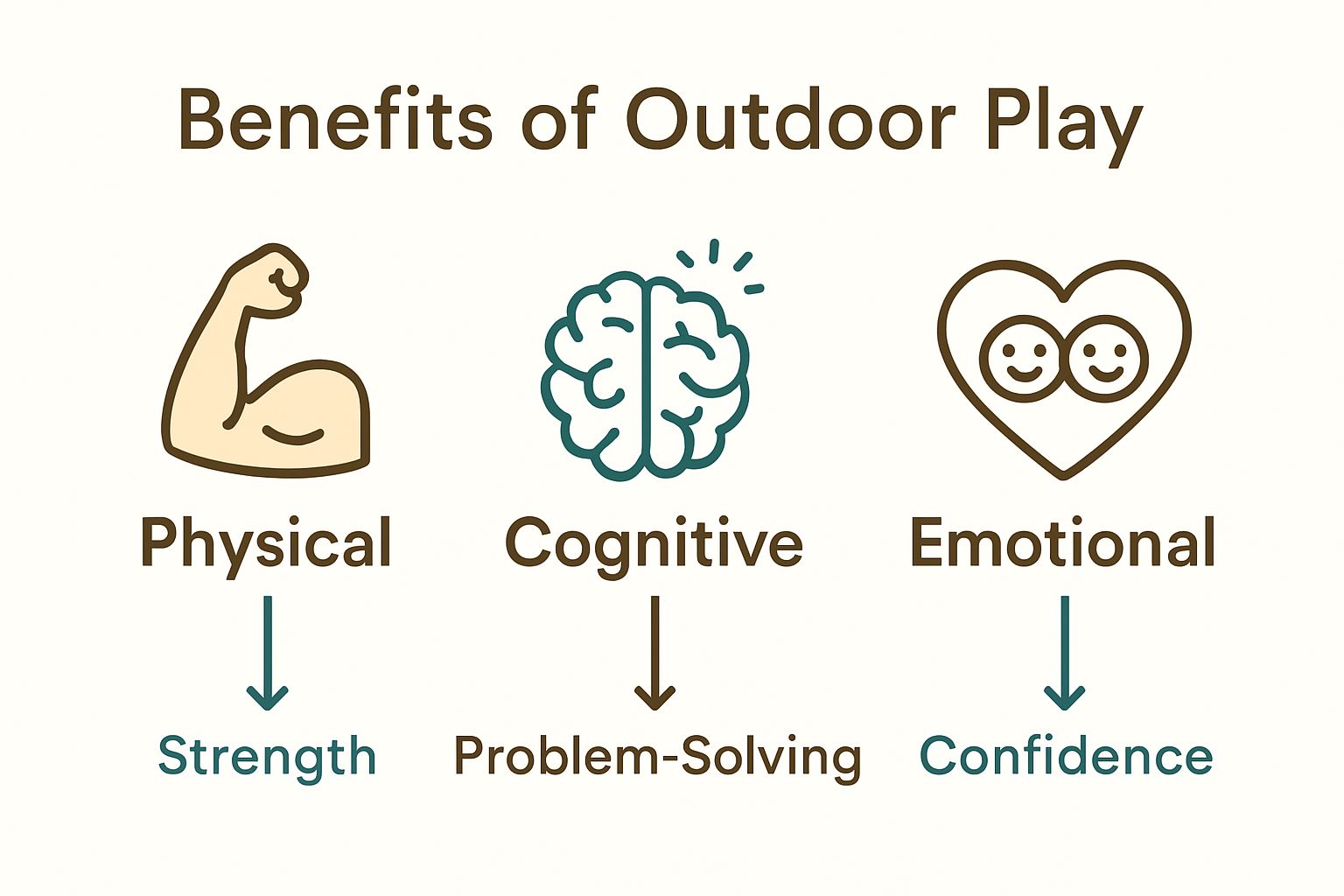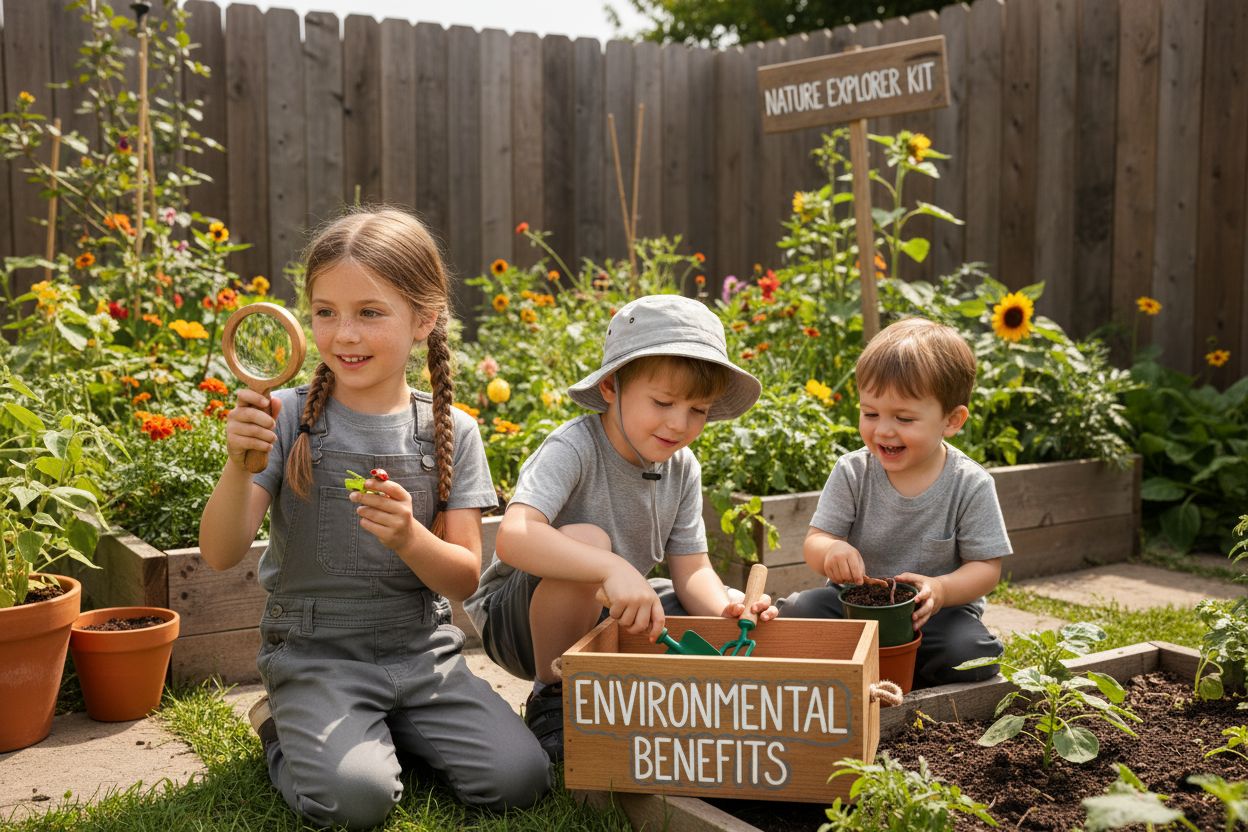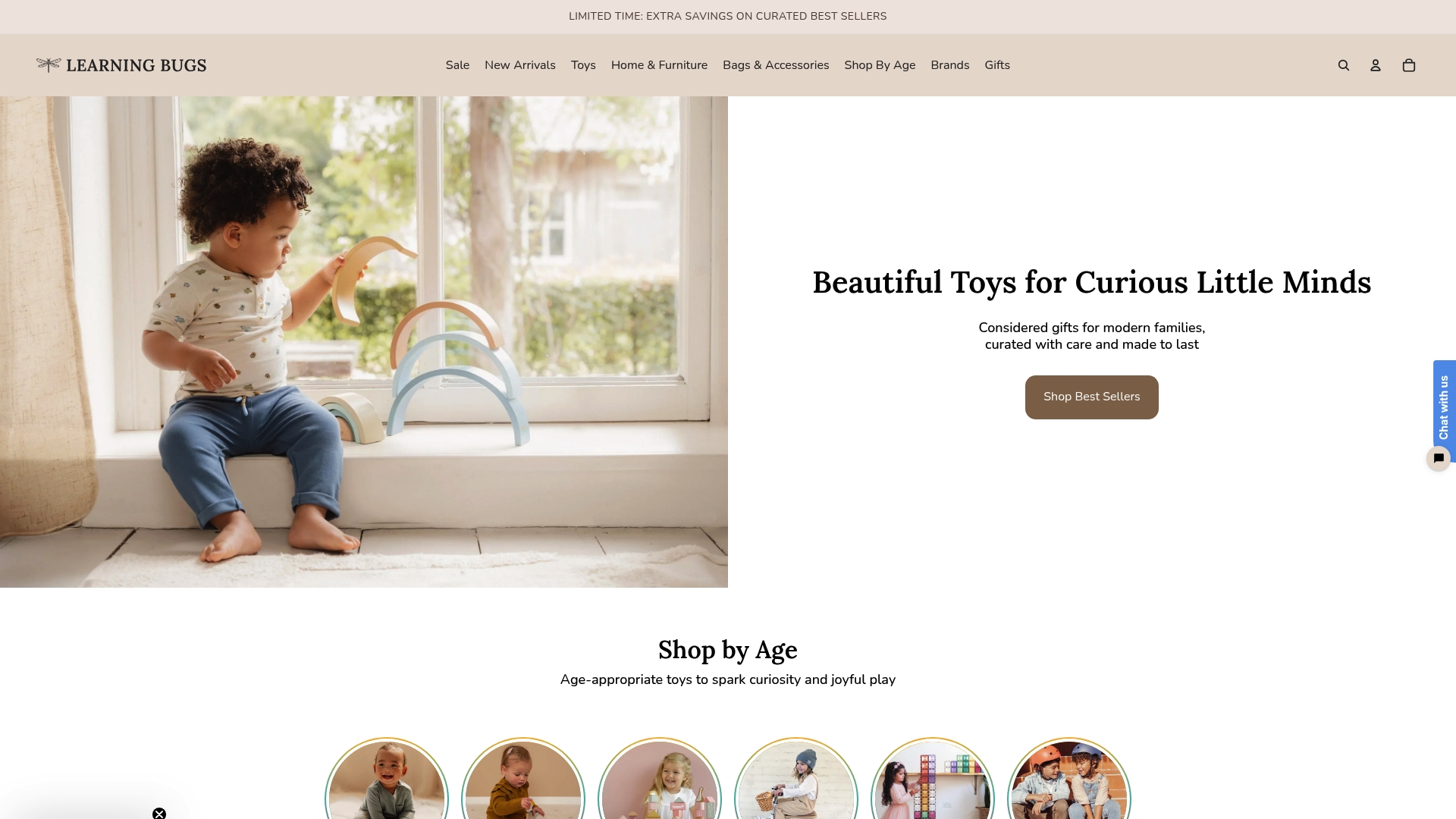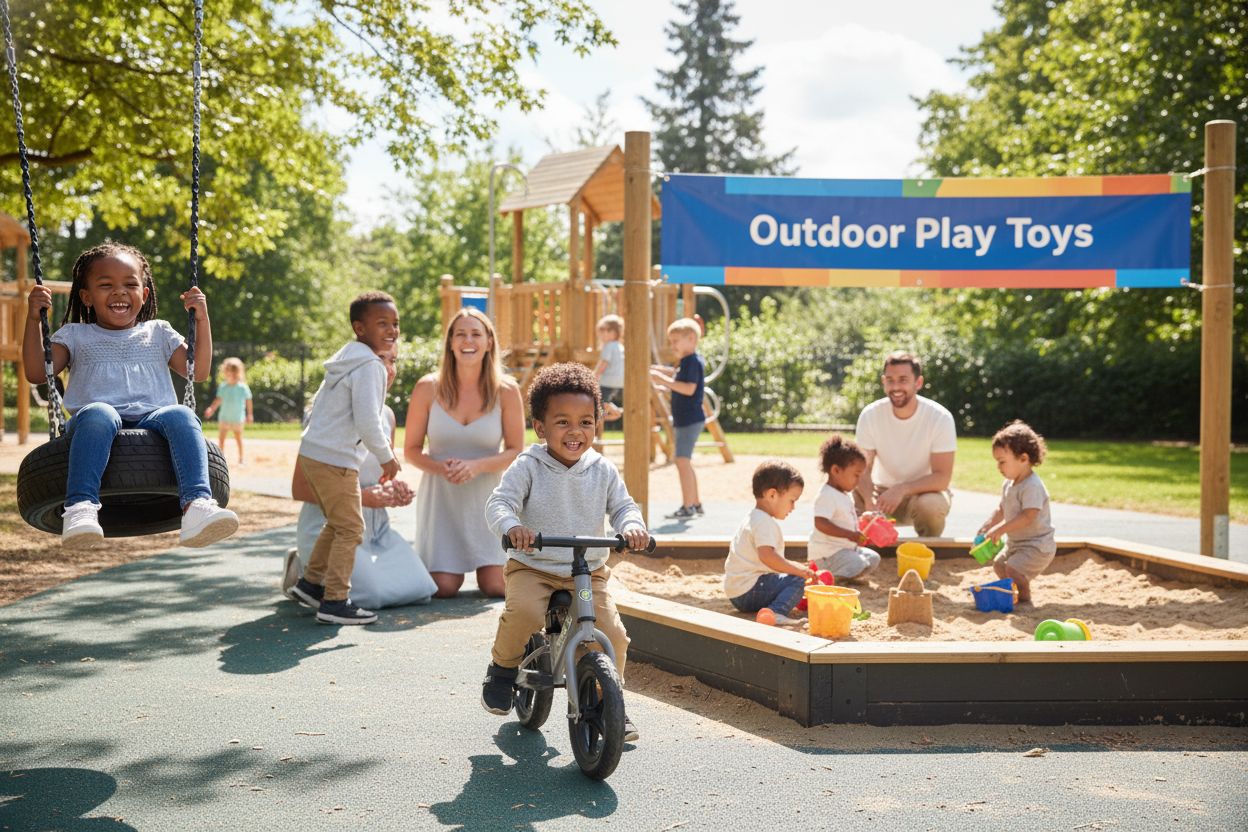Outdoor play shapes far more than just happy afternoons in the garden. Children who regularly play outside experience up to 30 percent higher physical activity levels compared to their peers who stay indoors. Most people think the real value in outdoor toys is all about fun and burning off energy. In reality, these playful moments are the foundation for strong bodies, confident minds and even a deeper connection to the natural world.
Table of Contents
- The Importance Of Outdoor Play For Child Development
- How Outdoor Play Toys Encourage Physical Activity
- The Role Of Imaginative Play In Outdoor Toys
- Environmental Benefits Of Outdoor Play And Toys
- Choosing The Right Outdoor Play Toys For Your Child
Quick Summary
| Takeaway | Explanation |
|---|---|
| Outdoor play promotes physical development. | It builds muscle strength, coordination, and motor skills through natural interactions with play equipment. |
| Imaginative play enhances cognitive skills. | Children use outdoor toys creatively, fostering abstract thinking and problem-solving abilities. |
| Social interactions develop emotional intelligence. | Outdoor play encourages children to negotiate and collaborate, enhancing their communication and empathy skills. |
| Choose age-appropriate outdoor toys. | Selecting toys that match a child’s developmental stage optimises their learning and physical ability growth. |
| Balance safety with adventurous play. | Outdoor toys should present challenges while ensuring safety, helping children gain confidence without unnecessary risk. |
The Importance of Outdoor Play for Child Development
Outdoor play represents a fundamental aspect of childhood development, offering far more than simple entertainment. It provides children with critical opportunities for physical, cognitive, and social growth that cannot be replicated through indoor activities.
The following table compares the different domains of child development supported by outdoor play toys, summarising the key benefits outlined in the article.
| Development Domain | Main Benefits Enabled by Outdoor Play Toys |
|---|---|
| Physical | Builds muscle strength, coordination, cardiovascular fitness, flexibility, and motor skills |
| Cognitive | Fosters problem-solving, creative thinking, narrative building, and abstract reasoning |
| Emotional | Facilitates self-regulation, emotional resilience, and confidence through overcoming challenges |
| Social | Enhances cooperation, negotiation, empathy, communication, and conflict resolution skills |
| Environmental | Instils ecological awareness, environmental responsibility, and connection with the natural world |
 Research from the NHS emphasises the profound impact of outdoor experiences on children’s overall well-being.
Research from the NHS emphasises the profound impact of outdoor experiences on children’s overall well-being.
Physical Development and Motor Skills
Engaging with outdoor play toys stimulates physical development in remarkable ways. When children climb, jump, run, and manipulate outdoor equipment, they are simultaneously building muscle strength, improving coordination, and developing fine and gross motor skills. These physical activities help children understand spatial awareness, balance, and body movement in a natural, unstructured environment.
Key physical benefits include:
- Enhanced muscle development
- Improved cardiovascular fitness
- Better hand-eye coordination
- Increased flexibility and agility
Cognitive and Emotional Growth
Beyond physical benefits, outdoor play provides rich sensory experiences that support cognitive development. Children learn problem-solving skills, understand cause-and-effect relationships, and develop creative thinking by interacting with natural environments. The unstructured nature of outdoor play encourages independent exploration and risk assessment, which are crucial for building confidence and resilience.
Emotional advantages emerge through social interactions, negotiation of playground dynamics, and managing challenging physical tasks. These experiences help children develop emotional intelligence, learn self-regulation, and build social skills in a dynamic, unpredictable setting.
For those seeking more insights into developmental play, our guide on educational toys offers additional perspectives on supporting children’s learning through play.
How Outdoor Play Toys Encourage Physical Activity
Outdoor play toys are not merely entertainment tools but strategic instruments designed to motivate children towards sustained physical movement and active engagement. Research from Public Health England indicates that purposefully designed outdoor play equipment can significantly increase children’s daily physical activity levels.
Motivational Design of Outdoor Play Toys
The most effective outdoor play toys are engineered to create intrinsic motivation for movement. By incorporating elements of challenge, excitement, and exploration, these toys transform physical activity from a potentially mundane task into an engaging experience. Climbing frames, balance beams, ride-on vehicles, and sports equipment are carefully crafted to invite children to push their physical boundaries while experiencing pure enjoyment.
Key design features that encourage movement include:
- Interactive elements requiring multiple muscle groups
- Varying difficulty levels to maintain interest
- Opportunities for creative physical exploration
- Sensory stimulation through different textures and movements
Progression of Physical Skills
Outdoor play toys serve as progressive learning tools that systematically develop physical capabilities. As children interact with different equipment, they naturally advance through stages of motor skill development.
From basic movements like jumping and climbing to more complex coordination tasks, these toys provide a structured yet playful environment for physical growth.
The progression typically involves developing fundamental movement skills such as:
- Balancing
- Throwing and catching
- Jumping and landing
- Spatial awareness
- Rhythmic movement coordination
For parents seeking additional insights into supporting children’s physical development, our guide to fine motor skills toys offers comprehensive strategies for nurturing children’s physical capabilities through purposeful play.
The Role of Imaginative Play in Outdoor Toys
Imaginative play represents a profound mechanism through which children explore, understand, and interact with their environment. Research from Child Development Studies reveals that outdoor toys which stimulate imaginative scenarios are critical for cognitive and emotional development.
Cognitive Development through Creative Scenarios
Outdoor toys that encourage imaginative play serve as powerful cognitive development tools. When children transform simple play equipment into elaborate narrative worlds, they engage complex mental processes. A climbing frame becomes a castle, a sandpit transforms into an archaeological dig site, and ride-on vehicles become spacecraft exploring unknown territories. These imaginative translations help children develop abstract thinking, narrative construction, and creative problem-solving skills.
Key cognitive benefits of imaginative outdoor play include:
- Enhanced language development
- Improved symbolic thinking
- Advanced narrative reasoning
- Expanded conceptual understanding
Emotional Intelligence and Social Learning
Imaginative play with outdoor toys provides a unique platform for emotional exploration and social skill development. Through role-playing scenarios, children learn to understand different perspectives, negotiate complex social interactions, and develop empathy. Collaborative imaginative play teaches children crucial interpersonal skills like communication, cooperation, and conflict resolution in a natural, engaging environment.
Important emotional learning aspects include:
- Understanding social roles
- Developing emotional regulation
- Practicing communication strategies
- Building interpersonal confidence
For parents interested in nurturing creativity through play, our guide on creative toys for gifts offers additional insights into selecting toys that spark imagination and learning.
Environmental Benefits of Outdoor Play and Toys
Outdoor play represents more than a simple childhood activity; it serves as a critical bridge connecting children with the natural world. Research from the Royal Horticultural Society demonstrates that direct interaction with outdoor environments can profoundly impact children’s environmental awareness and ecological understanding.
Developing Environmental Consciousness
Outdoor play toys that integrate natural elements provide children with tangible experiences of ecological systems. Gardening sets, nature exploration kits, and sustainable play equipment help children understand environmental interconnectedness. By engaging directly with soil, plants, and outdoor environments, children develop a sensory and emotional connection to the natural world that textbooks cannot replicate.

Key environmental learning opportunities include:
- Understanding natural ecosystem interactions
- Recognising local plant and animal species
- Developing respect for natural environments
- Learning basic ecological principles through hands-on experience
Sustainable Play and Ecological Awareness
Modern outdoor toys increasingly incorporate sustainable design principles, teaching children about environmental responsibility from an early age. Toys manufactured from recycled materials, biodegradable components, or sustainably sourced wood demonstrate practical examples of ecological consciousness. These toys not only provide play value but also serve as educational tools that communicate broader environmental messages about conservation, resource management, and sustainable living.
Important sustainable play considerations include:
- Choosing toys made from environmentally friendly materials
- Selecting durable play equipment that reduces waste
- Supporting manufacturers with transparent ecological practices
- Encouraging repair and long-term use of play items
Parents seeking deeper insights into supporting ecological learning can explore our latest news and educational resources for additional guidance on nurturing environmental awareness through play.
Choosing the Right Outdoor Play Toys for Your Child
Selecting appropriate outdoor play toys requires careful consideration of a child’s developmental stage, interests, and individual learning needs. Research from the British Psychological Society highlights the importance of age-appropriate and engaging play equipment in supporting healthy childhood development.
Age and Developmental Stage Considerations
Each developmental stage demands specific types of outdoor play toys that challenge and support a child’s growing capabilities. Younger children require toys that enhance basic motor skills and sensory exploration, while older children benefit from more complex equipment that encourages problem-solving and collaborative play. Understanding your child’s current physical and cognitive abilities is crucial in making informed toy selections.
This table presents key considerations when selecting outdoor play toys for children, relating each factor to the specific benefits or necessities as discussed in the article.
| Consideration | Description |
|---|---|
| Age Appropriateness | Match toy complexity to the child’s motor skill and cognitive development |
| Safety | Ensure equipment meets robust safety standards and supports appropriate supervision |
| Progressive Challenge | Offer toys that will develop with the child and encourage growth over time |
| Material Sustainability | Prioritise toys made from environmentally friendly or durable materials |
| Physical and Cognitive Fit | Choose toys that provide a suitable balance of activity, creativity, and problem-solving |
| Support for Social Play | Select toys that can be used collaboratively to encourage communication and empathy |
Key selection criteria based on developmental stages include:
- Matching toy complexity to motor skill levels
- Ensuring safety appropriate for specific age groups
- Providing progressive challenge and learning opportunities
- Supporting current cognitive and physical capabilities
Balancing Safety and Adventure
Outdoor play toys must strike a delicate balance between providing exciting challenges and ensuring child safety. High-quality toys should offer calculated risks that encourage children to push their boundaries while maintaining robust safety mechanisms. This approach helps children develop confidence, resilience, and physical competence without unnecessary danger.
Critical safety and adventure considerations include:
- Checking structural integrity and material quality
- Assessing potential injury risks
- Ensuring appropriate supervision during play
- Selecting toys with built-in safety features
For parents seeking expert guidance on making informed toy choices, our guide to fine motor skills toys provides additional insights into selecting developmentally appropriate play equipment.
Discover Outdoor Play Toys That Truly Nurture Growth
Are you searching for ways to turn outdoor play into real benefits for your child’s development? This article highlights how the right play toys support physical skills, spark imagination, and foster confidence – but finding toys that truly deliver can be a challenge. Many parents want to inspire active play, creativity, and emotional growth, yet struggle to choose safe, educational toys that offer genuine value.

Experience the difference with Learning Bugs, where every outdoor toy is thoughtfully chosen to encourage movement and discovery. Visit our latest news and educational resources for expert tips, or explore our range of fine motor skills toys that are designed to grow with your child. Give your family the lasting joy and benefits of purposeful play. Shop now and help your child thrive outdoors.
Frequently Asked Questions
What are the key benefits of outdoor play toys for children’s physical development?
Outdoor play toys enhance children’s physical development by improving muscle strength, coordination, cardiovascular fitness, and motor skills through active engagement like climbing, jumping, and running.
How do outdoor toys support cognitive and emotional growth in children?
Outdoor toys promote cognitive and emotional growth by encouraging problem-solving, creative thinking, and social interaction. Children learn to navigate challenges and develop emotional intelligence through unstructured play experiences.
What design features in outdoor play toys encourage children to be more physically active?
Effective outdoor play toys incorporate interactive elements, varying difficulty levels, and opportunities for creative exploration, which motivate children to engage in physical activity while having fun.
How can parents choose the right outdoor play toys based on their child’s developmental stage?
Parents should consider their child’s age and developmental stage by matching toy complexity to motor skills, ensuring safety, and providing progressive challenges that support growing abilities.

0 comments